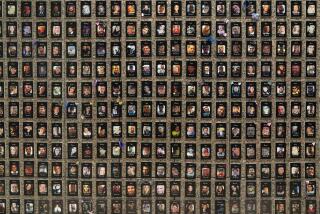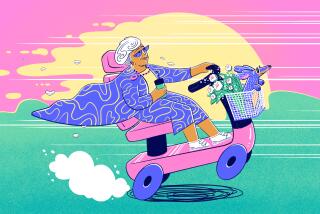Fear of Youth Flaws Blacks’ ‘Golden Years’
- Share via
When old people talk about youth, certain standard topics--clothes, values, fads--are apt to come up. But while surveying older people in the black community recently, Yolanda Becerra-Jones began to hear a new and troublesome variation on the usual themes.
The issue now is fear of young people. Many of those Becerra-Jones interviewed told stories of acquaintances who had been assaulted by youths. Others observed that the young people they know seem to have lost the reverence for life and respect for the aged that has kept previous generations from harming older, weaker members of society.
“We are not as stable, not as alert as the young people,” Vabel Reed, 69, said. “They (youths) seem to take advantage. They prey on us.”
A community outreach worker with the Senior Health and Peer Counseling Center in Santa Monica, Becerra-Jones spent 1 1/2 years visiting Westside low-income families in an effort to determine how the center could serve their needs.
While the Latino and Jewish seniors she visited voiced the usual gripes about youth--”my daughter doesn’t come to visit me enough”--Becerra-Jones said that in the black community, intergenerational conflict was the No. 1 worry.
That worry does not necessarily reflect a statistical increase in crimes against the elderly. An LAPD spokesman said that while his department doesn’t keep records on the ages of victims, there has been no apparent increase in victimization of elderly people in the L.A. area. A report from the U.S. Department of Justice reveals that, in fact, “younger people are much more likely than the elderly to be victims of crime.” (Blacks in every age group are more likely to be victimized, according to the 1983 Report to the Nation on Crime and Justice.)
Increasingly Mistrustful
Yet, the report goes on to say that, “the elderly have a greater fear of crime and may restrict their lives in ways that reduce their chances of being victimized.”
It is this fear that concerns Becerra-Jones; and the fact that, as part of their efforts to protect themselves, some old people have become increasingly mistrustful of youths in their own neighborhoods.
“Some people (she interviewed) mentioned things like money and politics (as stress factors in their lives) but the one thing they had in common was concern about the youth,” Becerra-Jones said. “A lot of them said they were worried that young people had lost an understanding of their culture. They were reluctant to bring their fears out in the open, to criticize their own people,” she added. “But at the same time they feel a real responsibility, and they don’t know what to do.”
According to Dr. Frederick Anderson, an associate professor of social work at USC, there have been efforts to address this issue at community forums in past years, “but the problem has intensified to the point where more serious attempts (to solve it) need to be made,” he said.
“This (youths aggressing against the elderly) did not occur when I was a kid,” he added. “When I was in school, the gangs fought with their fists and chains--but nobody got killed. Now we’re seeing young black adults beating up on elderly blacks. The situation is really deadly now.”
Anderson joined a roomful of seniors and a contingent of youths from Washington Preparatory High School in South-Central L.A. in a recent discussion on intergenerational turmoil. Organized by Becerra-Jones and the Senior Health Center, the well-attended gathering at the Calvary Baptist Church in Santa Monica was just the first in a planned set of meetings on the problem.
Becerra-Jones pointed out that old people of every race and ethnic background are susceptible to violence and conflicts with youth, but that several factors make the situation particularly acute within the black community.
“Black families are under unusual stresses,” Becerra-Jones said, citing a high level of unemployment and poverty. “There aren’t a lot of resources such as family counseling for black families in this area.”
It is in part because the black family was once a primary source of strength for individuals that the breakdown of that network is causing such trauma now, Anderson said.
Roberta Raiford, a 55-year-old family counselor and another speaker at the church session, said that in order to comprehend problems occurring now, she felt young people needed to understand the type of family most of their parents grew up in.
“We lived in an extended household with my mother, grandmother and grandmother’s father. We had cousins that lived all around us,” Raiford said. “We all took care of my great-grandfather. He used tobacco and all the children had to take turns emptying his can. When it was my turn, I got sick--but I still did it.
“It wasn’t just him, we took care of all the old people,” she added. “We learned how to cook from Mrs. Jones. We went to the store for Mr. John. We were not allowed to be paid to help anyone. We learned that you did not get paid for respecting people.”
One woman interviewed for the Becerra-Jones project said that a neighbor of hers had attempted to bridge the age-youth split by inviting a youngster from a Venice youth program into her home to help out with chores. The young man returned later and robbed and murdered the old woman who had employed him.
The violence does not have to be this extreme to effectively intimidate a physically vulnerable older person. Reed said she became fearful when some neighborhood children persisted in throwing rocks at the ducks she keeps as pets, even after she had asked them to stop. Reed, who has lived in the neighborhood since 1950, said, “The kids just got a thrill out of hurting them, and that hurt me.
“I said to the father of one of them: ‘If those kids are capable of hurting a duck, they’re going to hurt you someday. You think about that, sir.’ ”
The students who attended the Santa Monica forum were well-behaved and sympathetic to the seniors’ plight. In defense of youth, they simply pointed out the increasing pressures on young people that sometimes drive them to anti-social behavior.
Youths Invited
The youths who really needed to be present to answer to the seniors’ concerns did not attend, Anderson said. (Becerra-Jones said she had invited such youths through neighborhood contacts, but they apparently were not interested in participating.)
It was just as likely that those seniors who have been most severely wronged did not come to the meeting, afraid to state their grievances in public. Seniors can be reluctant to report assaults, Anderson said. “It’s very hard for them to testify, then to go back home where they live surrounded by graffiti.” The wall drawing serves as a reminder, he said, that youths control the neighborhood.
“We have cut the chain of the transmission of attitudes, values and plain common sense,” Anderson said. “There’s been almost a complete break with our (black) history.
“I asked a youngster the other day what he thought of apartheid. He’d never heard of it,” Anderson added. “They (children and teen-agers) don’t remember lynchings . . . . They never had to travel in a car with a bag full of chicken and sandwiches looking for a place where you would be allowed to stay overnight.”
Addressing the young people in the room, Anderson added: “These (old) people you see sitting here did not have affirmative action, but they made it and they’re hardy souls. Their coping mechanisms have confounded therapists. So when you hear an old person say religion has been their rock in a storm, it means something.
“If the old people are scared to death, they might as well be dead,” he said. “I want to urge the young people to bring out your protective instincts for older people.”
More to Read
Sign up for Essential California
The most important California stories and recommendations in your inbox every morning.
You may occasionally receive promotional content from the Los Angeles Times.










